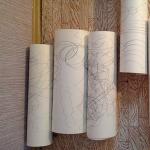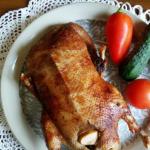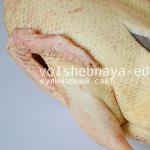Holniten or holinten are a special type of simple metal rivet for leather or fabric. With their help we can not only connect several parts structural elements leather goods, but also use them as figurative or ornamental decoration elements. Holnitens consist of two parts - a “leg” with a spike-like protrusion and a “cap” with a hole. Passing through the skin, the leg is combined with the cap, after which they are riveted
There are several types of holniten. One-sided, most known species Holnten, consisting of a leg with a flat base and a cap with a semicircular end. Double-sided holnitens consist of a stem and a cap with a semicircular base. Figured holnitens are a special type, consisting of a leg on a flat base and a cap in the form of a decorative figurine. Denim denim hats differ from single-piece ones in the decorative pattern applied to the hat. And finally, spherical holnitens, with a cap in the form of a hemisphere
Holnitens are also classified according to the length of the leg, which must be selected based on the thickness of the skin being connected, carefully selecting the optimal one. Because if the leg is not long enough, the holniten simply will not rivet, and if it is too long, the leg platform will be deformed, protruding into an ugly semicircle. Typically, the legs are produced in lengths from 0.5 to 2 cm, although some manufacturers may extend dimensions With special type holnitenah
The diameter of the cap is an important characteristic of any holniten. The required size is selected based on the uniqueness of the product and artistic design. Cap sizes usually start from 4.5 mm and end at 13-15 mm
There are many known color variations Holniten colors, but the most common, and therefore considered classic colors, are antique, nickel, gold and oxide.
As for the methods for installing holniten, there are only three of them. In the first method, we thread the holinten into a hole in the leather, put on a cap and simply rivet it with blows of a hammer or mallet with a wooden or plastic base. Although the Holnten cap loses its semicircularity and becomes flat, this method is very common due to its simplicity and cheapness, despite the danger of damaging the color of the cap with the hard surface of the hammer
The second method is the classic and most reliable, eliminating deformation of the stem and damage to the cap. This is the use hand press and special installation nozzles. This method Excellent for professional tanners or workshops, but somewhat expensive due to the fact that each head diameter uses its own nozzle, and the cost of equipment for installing holniten can be somewhat expensive. Another disadvantage of this method is the limited possibility of installing a rivet from the edge of the product due to the size of the press. that is, if the edges of the skin are easy to install, but for a distance of more than 7-8 cm, the press is not suitable
The third method, using hand bits for installation, is easy and simple, although it requires some professional training. We thread the holniten into the hole and apply special kind to the head and rivet it with several blows from hammers and mallets. The method is inexpensive and allows you to install curtains anywhere on the product; it is recommended for novice tanners.
Want to learn more about working with leather? Sign up for our seminars at the Leather Craft School
How to install rivets manually? Device for installing holniten.
How to install holniten using improvised means, or how to install holniten at home
The easiest way to install holniten is made of cast metal.  As a rule, they are made of light metal alloys.
As a rule, they are made of light metal alloys.
The metal is durable and does not flatten. It is recommended to install on wooden surface to avoid scratches.
If you install the cold one on thin layer fabric, it is better to use a cropped denim stud  6mm high. A regular all-metal denim nail has a height of 8.5-9mm
6mm high. A regular all-metal denim nail has a height of 8.5-9mm  But if you don’t have a suitable size at hand, then it’s easy to make it using a side cutter.
But if you don’t have a suitable size at hand, then it’s easy to make it using a side cutter. 
Next, we pierce the fabric (with an awl or a nail), insert a denim nail, put on the holniten and hammer it in with a hammer, but not with all your might, otherwise you will break the holniten. 
To check, we remove the side cutter and see that the denim nail is completely inserted and holds the side wall tightly.  You don't have to do this, but if you are very curious, then please do so.
You don't have to do this, but if you are very curious, then please do so.
Single-sided holniten Ø7 and 9mm can also be installed using a hammer. 
In addition to all-metal denim nails, you can use tubular denim nails 
It is more difficult to hammer them in, as more precise alignment (impact accuracy) is required.
Due to the fact that to install the part it is necessary to maintain at least relative alignment, we will build an appropriate device from auxiliary materials. You will need a tube (internal diameter 9-10mm) and a rod - a bolt with a head diameter of 9mm.
Something like this.  IN in this case We use a Ø9mm socket wrench.
IN in this case We use a Ø9mm socket wrench.
It is desirable that the bolt head be smooth.
Example: Using this simple device, we install a one-sided holniten Ø9mm. We install it on a metal or wooden surface, so as not to scratch the front surface of the holniten, we put one layer of paper. Do not hit with all your might, but use short and precise blows to establish a relaxed position. 
The most difficult thing to install without special attachments are shaped holitens. 
It is unlikely that you will be able to install them without defects, so it is better not to mess with them.
Holniten, holiteny, haliteny, halniten
Holniten- simply riveting For clothes, bags, shoes. Accessories, consisting of two parts: cap and legs. When installed, the leg bends inside the cap and holds very tightly.
How to choose a holniten?
Are being selected holniten By like, form, blossom, diameter And leg length .
Holniten There are one- and two-sided ones. In one-sided ones, the leg is open,used where the reverse side is not visible or where a flat inner surface of the product is needed.
In double-sided ones, the leg is closed in the same way as the cap; after installation, such a holniten looks the same on both the front and back sides.
In addition, according to the scope of application, there are handbags(photo above) and denim jeans. Bags have a hollow leg rounded at the end.
U denim the stem is a sharp stud.
The shape of the hats is smooth, hemispherical, embossed, patterned, round, studded and many others for decoration and design.
Primary colors: nickel(silver), oxide(black), antique(old gold, bronze), copper(with a red tint). Sometimes holniten coated with enamel, this way you can get any color and a much more beautiful appearance with a glossy shine. Painted fittings are more expensive, but are resistant to scratches.
Diameter holnitena is called the diameter of the cap. You also need to know the length of the stem - it varies for different holnitens.
The length of the leg should be chosen 1-2 mm more than the thickness of the material. From 1 to 3 mm easily bends in the cap without harm appearance and quality of installation. Often there is a notch on the leg for bending - you can also use it as a guide when choosing accessories.
The diameter of the stem is usually 1.5-2mm; on large holnitens the stem is thicker.
The material must meet technical requirements for color, strength and moisture resistance. As a rule: steel, less often - stainless steel, coated steel.
How to install a holniten?
First of all, a location for installation on the material or product is selected. Better to install holniten on 2-3 layers of material, so that the material is tightly clamped with the leg and cap. After choosing a place, a hole punch is made through hole 1.5-2mm, where the leg of the holniten is inserted (it is believed that the nail of the denim holniten should pierce the hole itself, but in practice this is quite difficult to do). hat holnitena inserted into silicone tube the top of the press nozzle. The leg is placed on the lower part of the nozzle. One press and that’s it, the holniten is installed. It is important not to overpress so that the fittings do not “eat into” the product.
Application:
Usually, holniten used to strengthen the joints of the material where load is likely and the seam can break: pockets, places where handles are attached to bags, etc. Also widely given accessories used in decorative solutions in production belts, wallets, bags, clutches, shoes, jackets.
Below are the application options holniten:
- menus for restaurants, brochures, folders, presentation materials, scrapbooking:
Good afternoon. Today I will look at holniten or, in common parlance, clothing rivets. And how to install them. The agony of searching in the city under the cut...
I needed it for handmade crafts(I won’t talk about which ones, you’ll leave them in the comments) several rivets exactly like those being reviewed. In our city, we don’t have anything like this in any sewing store. I even went to the studio, some didn’t have it in stock, some did, but they only had installation at a price of 50 rubles per piece, so they didn’t sell it individually.
I finally found it in China. There were 200, 500, and more pieces on sale. I found 100 pieces ( and ) from two sellers and ordered them in a “batch.”
As expected, the rivets arrived just as needed. I ordered on the same day, but they arrived a week apart.
Since the rivets are the same, there is no way to track which seller came from which one. The only difference is that from one they came packaged in different bags, and from the other in one.
So what are rivets? What can I tell you... everything can be seen from the seller’s pictures.
The material, according to the seller, is brass. Consist of two parts. I don’t know what it’s called: from a spire and a cap. The lid fits tightly onto the pin and won’t just fall off during “installation.”
So about the installation. After watching enough on YouTube and reading forums about rivets, I concluded that they are riveted either with a special press or manually. By the way, the press costs about 3,000 rubles.
From the information received, without a press, the rivets are simply driven in (flattened) according to the principle of driving a nail with a hammer.
Let's get started: take a sling (it is also called a belt); 
pierce with a spire; 
put on the cap and slowly hammer it in with a hammer. The result will be something like this: 
I also learned from the forums that to eliminate distortions, you can use a suitable bushing and drive a bolt of the appropriate size through it. Centering helps to avoid a large distortion, but a small defect appears on the cover 
In this way, having flattened a small pile of rivets (about 15 pieces, and I ended up with 200 pieces from two sellers), I got angry and took ordinary pliers and squeezed the rivet. And, lo and behold, the rivet shrank perfectly. No distortions, no deformation of the lid. Since this was only a trial and spontaneous choice of instrument, a slight bias is still visible. But it’s invisible on the sling.
As an example, here are rivets cut from a sling: 
I settled on using pliers.
Bottom line. I was pleased with the rivets. No fingers were harmed during installation.
If I helped anyone with the choice of rivets, please.
Well done to those who have mastered a lot of text. For those who haven't mastered it, that's fine.
I'm planning to buy +25 Add to favorites I liked the review +29 +55



